

Teacher Infographics.

ISTE 2014: Reflective Teacher's Guide to PBL. 6 tips for making the most of PBL. Editor’s note: This is the first in a four-part blog series from the co-authors of Reinventing Project-Based Learning: Your Field Guide to Real-World Projects in the Digital Age. Do you have an idea for a project-based learning (PBL) experience that you think your students will love? Maybe the project idea was sparked by their questions. Perhaps it relates to a hot topic that you know they care about. Maybe you heard about a successful project from another teacher and want to re-create it with your students. These are all good starting places for PBL.
Pondering that question will prompt you to consider what you hope to accomplish with this project. The early planning stage is time for you, as the project architect, to focus on the big ideas. For starters, you might skim the standards for your grade level and ask yourself, What do these add up to? Once the project’s big ideas come into focus, you’re ready to look for more specific learning objectives.
Start with your learning goals. High Tech High - Project Based Learning. Seven Successful PBL Projects In March 2005 High Tech High received a $250,000 grant from the California Department of Education to disseminate project-based learning methods to teachers in non-charter public schools.
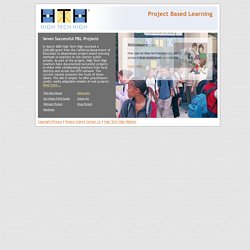
As part of the project, High Tech High teachers have documented successful projects to share with collaborating teachers from local districts and across the HTH network. The current volume presents the fruits of these labors. The aim is simple: to offer practitioners useful, easily adaptable models of real projects. Read more... This New House How does human habitation affect the environment? Learn more » Millionaire How can an idea be transformed into a product that could make us millions? Learn more » San Diego Field Guide How can we be better environmental stewards of the San Diego Bay? Learn more » High Tech High - Project Based Learning.
What does the effective implementation of project-based learning (PBL) look like within a school or across an entire system?

There's no one right answer, according to superintendents and school leaders who have started down this path. Some leaders want to see wall-to-wall PBL, with students learning mainly through projects in every subject. Others set a more realistic goal, hoping to see students taking part in projects at least a few times during the school year. For strategic reasons, leaders may choose to concentrate PBL rollouts in certain subject areas, such as STEM, or launch PBL initiatives at specific grade levels or pilot sites.
Whether the goal is for projects to happen occasionally or every day, in one building or across an entire school system, lasting results require thoughtful leadership. "Why PBL? " Leaders can expand this conversation by asking: How to Build Your Makerspace. Learning by making has been around since long before edtech—just think about what the adventurous explorers or intrepid settlers of yore would have thought of "Do-It-Yourself.
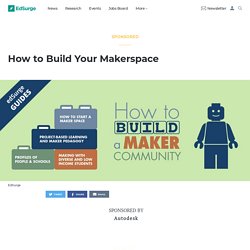
" But with thousands of kid-friendly tech tools and a whole World Wide Web of resources out there, creative, interesting opportunities for learning-by-making abound for everyone. Okay, so with all those resources, where should you start to build a makerspace? Untitled. PBL and STEAM Education: A Natural Fit. Both project-based learning and STEAM education (science, technology, engineering, art and math) are growing rapidly in our schools.
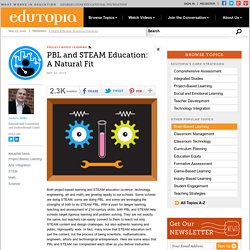
Some schools are doing STEAM, some are doing PBL, and some are leveraging the strengths of both to do STEAM PBL. With a push for deeper learning, teaching and assessment of 21st-century skills, both PBL and STEAM help schools target rigorous learning and problem solving. They are not exactly the same, but teachers can easily connect to them to teach not only STEAM content and design challenges, but also authentic learning and public, high-quality work. In fact, many know that STEAM education isn't just the content, but the process of being scientists, mathematicians, engineers, artists and technological entrepreneurs. Here are some ways that PBL and STEAM can complement each other as you deliver instruction.
From Design Challenges to Authentic Problems Many of us have experienced, either as a teacher or student, the bridge design challenge. Project-Based Learning: STEM to STEAM from lynda.com. Probing Question: Is art an essential school subject? For decades, "reading, writing, and 'rithmetic" were considered the most fundamental subjects in American K-12 schools.
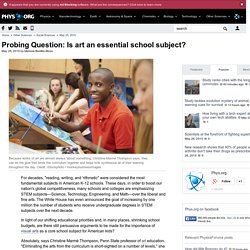
These days, in order to boost our nation's global competitiveness, many schools and colleges are emphasizing STEM subjects—Science, Technology, Engineering, and Math—over the liberal and fine arts. The White House has even announced the goal of increasing by one million the number of students who receive undergraduate degrees in STEM subjects over the next decade. In light of our shifting educational priorities and, in many places, shrinking school budgets, are there still persuasive arguments to be made for the importance of visual arts as a core school subject for American kids?
Absolutely, says Christine Marmé Thompson, Penn State professor of art education. "Eliminating the arts from the curriculum is short-sighted on a number of levels," she says. Explore further: A scientific look at the art of teacher talk. Sign in - Google Accounts. Using Technology to Help Students Show Their Thinking. Innovator Using Technology to Help Students Show Their Thinking By Dan Gordon05/19/15 Mark Hammons, the educational technology coordinator at the Fresno County Office of Education, is a trainer, speaker and former music teacher and percussion director.

He devotes much of his professional time to coaching Fresno educators through hands-on learning sessions as well as sharing ideas at ed tech conferences. An Apple Distinguished Educator and Google Certified Teacher, Hammons talks here about the many ways that technology can show what students are thinking. THE Journal: What’s the goal when you hold coaching sessions within Fresno schools and districts? THE Journal: What would be an example of a strategy you’ve adopted to allow students to show their thinking process through technology? THE Journal: You’re a big proponent of Classroom, Google’s free learning management system. THE Journal: Has your background in music given you any particular ideas pertaining to educational technology?
Project-Based Learning Activity. A Project-Based Learning Activity About Project-Based Learning What Is Project-Based Learning?
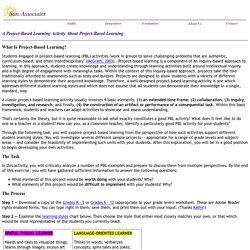
Students engaged in project-based learning (PBL) activities "work in groups to solve challenging problems that are authentic, curriculum-based, and often interdisciplinary" (McGrath, 2003). Project-based learning is a component of an inquiry-based approach to learning. In this approach, students create knowledge and understanding through learning activities built around intellectual inquiry and a high degree of engagement with meaningful tasks. Within the context of this inquiry-based approach, projects take the role traditionally afforded to assessments such as tests and quizzes. AM PBL Challenges - PBL Projects. Return To Main Challenge Page An Advanced Manufacturing Curriculum and Professional Development Project funded by the Advanced Technology Education program of the National Science Foundation Welcome to the AM PBL Project curriculum!
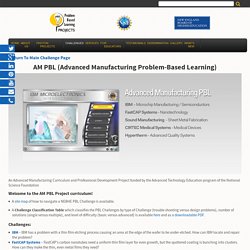
A site map of how to navigate a NEBHE PBL Challenge is available.A Challenge Classification Table which classifies the PBL Challenges by type of Challenge (trouble shooting versus design problems), number of solutions (single versus multiple), and level of difficulty (basic versus advanced) is available here and as a downloadable PDF. Challenges: IBM – IBM has a problem with a thin film etching process causing an area at the edge of the wafer to be under-etched. Standards Alignment: The AM PBL Challenges (in process) will be aligned to the Accreditation Board of Engineering and Technology (ABET), the Common Core State Standards, and the National Council for Accreditation of Teacher Education (NCATE) criteria. STEM Activities and STEM SOS Model - Google Slides.
7 Red-Hot Project-Based Learning Trends to Ignite Your STEM Classroom in 2015. Project-based learning (PBL) is one of the hottest topics in education, from language to library science.
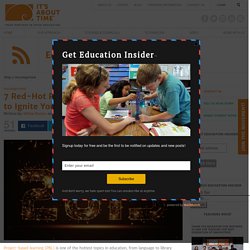
Yet, no area of education is more excited about PBL than science, technology, engineering, and math (STEM) teachers. According to a recent article in KQED Education (Is Project-Based Learning the Way to Go? By the California Academy of Sciences), more than 5,000 schools have adopted PBL as a major component of their STEM curriculum.
This much is clear, PBL in STEM is on fire!